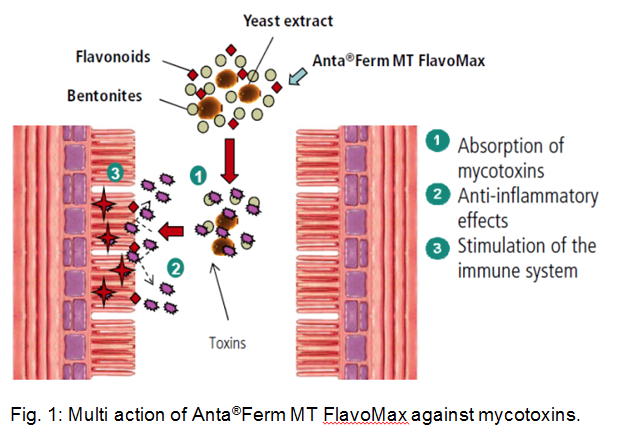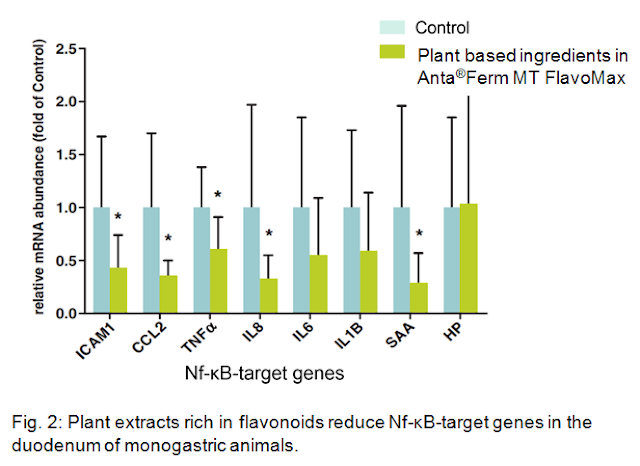Mycotoxin contamination of feed stuff often involves multiple toxins affecting various aspects of animal health, gut integrity, and animal performance. This is mainly caused by the detrimental effects mycotoxins have on the immune system, the gut barrier or the oxidative status of the animals. Effects that can be seen are, for instance, enlarged or shrunken organs as well as inflamed tissues. Binding components efficacy is essential to prevent the maximum of toxins from entering the digestive tract.
But as mycotoxins and their metabolites are so numerous with different chemical structures (polarity, size, conformation, etc), no binder is able to bind efficiently all categories of mycotoxins. In addition to special care to prevent the growth of moulds, detoxification measures, reduction of gastrointestinal absorption with mycotoxin binders, there is a need for prevention of the mycotoxin-induced toxic effects once the toxin is ingested. Nutritional approaches, such as supplementation of nutrients, food components, or additives with protective effects against mycotoxin toxicity are gaining interest. In response, Dr Eckel has developed a new generation of mycotoxin binder to face the challenges of modern animal production.
Comprehensive solution fights 4 main toxicity mechanisms
Anta®Ferm MT FlavoMax is a comprehensive solution that targets the 4 main toxicity mechanisms to prevent the harmful effects of a wide range of mycotoxins. Anta®Ferm MT FlavoMax impacts directly on the toxins (binding components) and on the animal, activating its own natural defences (fig 1):
But as mycotoxins and their metabolites are so numerous with different chemical structures (polarity, size, conformation, etc), no binder is able to bind efficiently all categories of mycotoxins. In addition to special care to prevent the growth of moulds, detoxification measures, reduction of gastrointestinal absorption with mycotoxin binders, there is a need for prevention of the mycotoxin-induced toxic effects once the toxin is ingested. Nutritional approaches, such as supplementation of nutrients, food components, or additives with protective effects against mycotoxin toxicity are gaining interest. In response, Dr Eckel has developed a new generation of mycotoxin binder to face the challenges of modern animal production.
Comprehensive solution fights 4 main toxicity mechanisms
Anta®Ferm MT FlavoMax is a comprehensive solution that targets the 4 main toxicity mechanisms to prevent the harmful effects of a wide range of mycotoxins. Anta®Ferm MT FlavoMax impacts directly on the toxins (binding components) and on the animal, activating its own natural defences (fig 1):
- Binding of mycotoxins
- Reduction of oxidative stress
- Protection of the gut barrier function including anti-inflammatory effects along the digestive tract
- Modulation of the immune system
Binding of mycotoxins.
Anta®Ferm MT Flavomax includes a proven combination of selected mineral clays and yeast cell walls, showing an excellent binding efficacy of different mycotoxins (Lohölter et al. 2013). The selected mineral clays bind mycotoxins in their interlayers by a process called chemisorption. Yeast cell walls are composed of complex polymers of β-(1,3)/(1,6) glucan, mannan-oligosaccharide (MOS) and chitin. MOS is located on the surface of the cell wall and plays an important role in binding mycotoxins and improving the micro-environment of the animal’s digestive tract. The efficacy of glucomannan-containing yeast products as mycotoxin absorbents in feed has been investigated in several studies on animals. As a mycotoxin binder, yeast cell walls have numerous characteristics including: Binding mycotoxins, especially zearalenone (ZEN); unaffected by the pH of the gastrointestinal tract; without changing nutritional value (regarding mineral and vitamin) in feed; no residue in animal.
Reduction of oxidative stress.
Reduction of oxidative stress.
Some mycotoxins (ie, OTA, FB1, AFB1, DON, and T2) have been known to produce damages by increasing oxidative stress. The animal has to detoxify mycotoxins, which is called xenobiotic metabolisation. During this detoxification process, free radicals are produced that increase levels of oxidative stress resulting in DNA damage, lipid peroxidation and inflammation or cell death. Practical implications can be reduced health status, increased incidence and severity of inflammations or skin disorders. The flavonoids in Anta®Ferm MT FlavoMax have shown to reduce oxidative stress by deactivating reactive radicals in the body (Gessner et al 2013).
Protection of the gut barrier function including anti-inflammatory effects along the digestive tract
Protection of the gut barrier function including anti-inflammatory effects along the digestive tract
The intestinal epithelium has many different functions. One is the absorption of nutrients. It is also the first protective barrier between the gut lumen and the animal’s blood stream. Several studies have shown that mycotoxins such as DON and OTA reduce the protective function of the gut wall. A meta-analysis published by Grenier and Applegate (2013) reviews how mycotoxins can modulate intestinal functions. In terms of morphology of the intestinal villi, studies show that feeding poultry low or moderate levels of deoxynivalenol (DON) alone or combined with other fusariotoxins leads to a reduction in villi height in both the duodenum and jejunum. Practical implications can range from diarrhoea, inflammation and fever to reduced feed efficiency. In a series of trials, the plant based ingredients in Anta®Ferm MT FlavoMax have shown to act as an anti-inflammatory agent along the digestive tract, having a positive effect on the integrity of the intestinal epithelium resulting in an improved feed conversion ratio (fig 2).
Modulation of the immune system
Modulation of the immune system
Since not all mycotoxins can be neutralised by binding, it is important to include additional mechanisms that go beyond binding to maintain optimal performance. A well-functioning immune system contributes to high performing animals. Anta®Ferm MT FlavoMax includes B-Glucans, which have been shown to activate macrophages, improve lymphocyte proliferation, reduce pathogen attachment and improve vaccination response – a powerful boost for the immune system.
Binding components efficacy is essential to prevent the maximum of toxins from entering the digestive tract. But as mycotoxins and their metabolites are so numerous with so many different chemical structures (polarity, size, conformation, etc), no binder is able to bind efficiently all categories of mycotoxins in a sufficient way. Anta®Ferm MT FlavoMax stimulates an animal’s natural defences in three essential ways: it prevents tissues peroxidation, boosts immune response and reduces inflammation along the digestive tract caused by mycotoxins.
If you have any questions about mycotoxin binders and the benefits of Anta®Ferm MT FlavoMax, please contact us for advice:
Monika Korzekwa
Technical Sales
Mail: m.korzekwa@dr-eckel.de
Phone: +49 (0) 2636 9749 28
Binding components efficacy is essential to prevent the maximum of toxins from entering the digestive tract. But as mycotoxins and their metabolites are so numerous with so many different chemical structures (polarity, size, conformation, etc), no binder is able to bind efficiently all categories of mycotoxins in a sufficient way. Anta®Ferm MT FlavoMax stimulates an animal’s natural defences in three essential ways: it prevents tissues peroxidation, boosts immune response and reduces inflammation along the digestive tract caused by mycotoxins.
If you have any questions about mycotoxin binders and the benefits of Anta®Ferm MT FlavoMax, please contact us for advice:
Monika Korzekwa
Technical Sales
Mail: m.korzekwa@dr-eckel.de
Phone: +49 (0) 2636 9749 28
Visit the Dr Eckel site HERE.
The Global Miller
This blog is maintained by The Global Miller staff and is supported by the magazine GFMT
which is published by Perendale Publishers Limited.
For additional daily news from milling around the world: global-milling.com




No comments:
Post a Comment